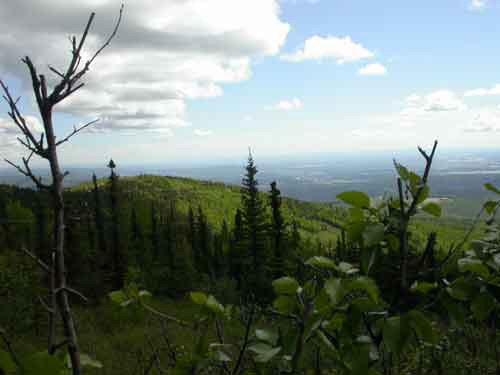
Northern greenery seems to be on the increase, according to scientists who watch Alaska changes in satellite images. Ned Rozell photo.
More Alaska news from San Francisco
I just returned from the American Geophysical Union fall meeting in San Francisco, a weeklong gathering of almost 12,000 scientists. My notebook is heavy. I lighten it here:
- Columbia Glacier in Prince William Sound is North America’s largest single contributor to rising sea level, according to Tad Pfeffer of the University of Colorado at Boulder. Columbia delivers 10 percent of what Alaska and Yukon glaciers are putting into the ocean, he said. Each year, the glacier spits 2 cubic miles of ice into the ocean, the equivalent of 100,000, 500-foot barges packed with ice.
- The number of lakes in an Alaska-size area of Siberia decreased from 10,882 to 9.712 between 1973 and 1997, said Laurence Smith of the UCLA Department of Geography. Despite the decrease, lakes in the North grew larger because of collapses that happen during the early stages of thawing permafrost, he said.
- Before the magnitude 7.9 earthquake of November 2002, the last major earthquake to rip the Denali fault occurred between 340 to 700 years ago on its eastern portion. The eastern portion is the segment through the central Alaska Range, across the Richardson Highway and the Tok Cutoff Road that sheared in 2002. On the western portion that didn’t rupture in 2002, including the Parks Highway near the town of Cantwell, the last big earthquake may have occurred about 200 years ago. Scientists, including David Schwartz of the USGS in Menlo Park and Alaska researchers Patty Burns and Peter Haeussler, have dug into different portions of the Denali fault since the earthquake, unearthing clues that help them refine the dates of the last large earthquakes on the fault.
- In the last two summers, fire has ravaged 10.5 percent of Interior Alaska, according to Eric Kasischke of the University of Maryland. On average, there is one large fire in the boreal forest every five years, he said.
- Averaging the results of nine major climate models that scientists use to simulate the future, ocean circulation will gradually decrease by 25 percent by the year 2100, said Andreas Schmittner of Oregon State University. The models did not show a sudden collapse in ocean circulation that might lead to abrupt climate change.
- Alaska has shown an increase in summer greenery each year since the early 1980s, according to John Kimball of the University of Montana, who used satellite data of photosynthetic leaf area and a computer model to reach his conclusion.
- Kangerlussuaq Glacier in east Greenland now has the title of fastest-moving glacier in the world, spilling into the sea at a rate of about 8 miles per year, more than 40 yards each day, according to Bill Krabill of NASA Goddard Space Flight Center.
- If all the ice in Greenland melted (which scientists don’t expect to happen in the near future), sea level would rise about 21 feet, according to Waleed Abdalati of NASA Goddard Space Flight Center. The ice fields in Canada’s high arctic contain about one-half inch of sea level equivalent, and the rest of the world’s glaciers and ice caps would add about two feet to the ocean level if they melted, he said.
- Northern sea ice will melt enough in summer to allow ships to sail through the Arctic Ocean by the year 2025, according to a sea ice model simulation reported by Marika Holland of the National Center for Atmospheric Research.
- Of 23 lakes near Council, on Alaska’s Seward Peninsula, 21 have shrunk during last 50 years, according to Larry Hinzman, a research professor of water resources at the University of Alaska Fairbanks. The shrinkage is probably due to drainage through thawing permafrost.
- Permafrost would increase in a world with no snow, according to Stephen Vavrus of the University of Wisconsin Madison, who used a computer model to simulate what would happen to global temperatures using the sad (and unlikely) scenario of a snowless planet.





